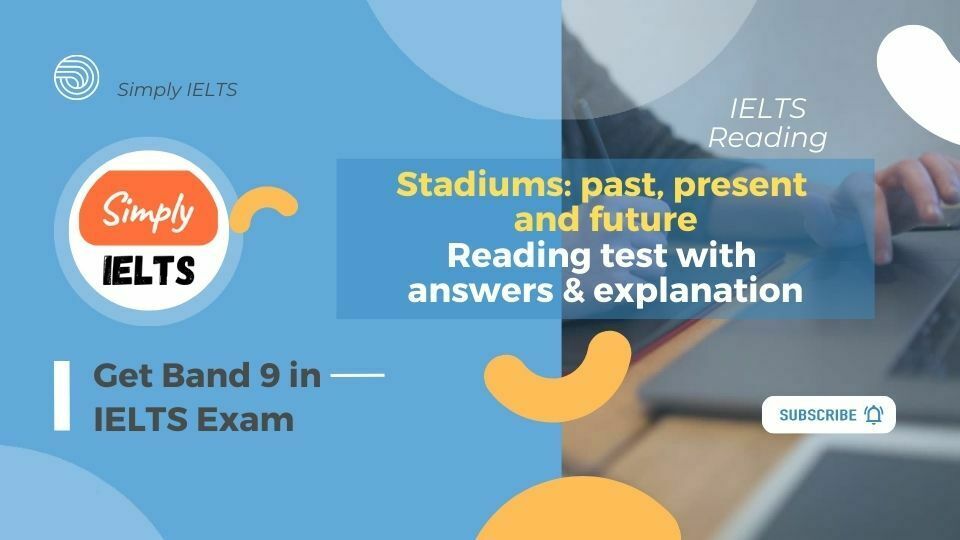Stadiums: past, present and future IELTS reading test with answers and explanation
A new IELTS Reading Academic test passage 2 from Cambridge IELTS 17 Reading test 1 Stadiums: past, present and future reading test with answers and location
In this IELTS Reading exam, you will find Should we try to bring extinct species back to life reading test answers with location and explanation

In the answers tab, you can find Stadiums: past, present and future reading answers with location
READING PASSAGE 2
You should spend about 20 minutes on Questions 14-26 which are based on Reading Passage 2 below.
Stadiums: past, present and future
A
Stadiums are among the oldest forms of urban architecture: vast stadiums where the public could watch sporting events were at the centre of western city life as far back as the ancient Greek and Roman Empires, well before the construction of the great medieval cathedrals and the grand 19th- and 20th-century railway stations which dominated urban skylines in later eras.
Today, however, stadiums are regarded with growing scepticism. Construction costs can soar above £1 billion, and stadiums finished for major events such as the Olympic Games or the FIFA World Cup have notably fallen into disuse and disrepair.
But this need not be the cause. History shows that stadiums can drive urban development and adapt to the culture of every age. Even today, architects and planners are finding new ways to adapt the mono-functional sports arenas which became emblematic of modernisation during the 20th century.
B
The amphitheatre* of Arles in southwest France, with a capacity of 25,000 spectators, is perhaps the best example of just how versatile stadiums can be. Built by the Romans in 90 AD, it became a fortress with four towers after the fifth century, and was then transformed into a village containing more than 200 houses. With the growing interest in conservation during the 19th century, it was converted back into an arena for the staging of bullfights, thereby returning the structure to its original use as a venue for public spectacles.
Another example is the imposing arena of Verona in northern Italy, with space for 30,000 spectators, which was built 60 years before the Arles amphitheatre and 40 years before Rome’s famous Colosseum. It has endured the centuries and is currently considered one of the world’s prime sites for opera, thanks to its outstanding acoustics.
C
The area in the centre of the Italian town of Lucca, known as the Piazza dell’ Anfiteatro, is yet another impressive example of an amphitheatre becoming absorbed into the fabric of the city. The site evolved in a similar way to Arles and was progressively filled with buildings from the Middle Ages until the 19th century, variously used as houses, a salt depot and a prison. But rather than reverting to an arena, it became a market square, designed by Romanticist architect Lorenzo Nottolini. Today, the ruins of the amphitheatre remain embedded in the various shops and residences surrounding the public square.
D
There are many similarities between modern stadiums and the ancient amphitheatres intended for games. But some of the flexibility was lost at the beginning of the 20th century, as stadiums were developed using new products such as steel and reinforced concrete, and made use of bright lights for night-time matches.
Many such stadiums are situated in suburban areas, designed for sporting use only and surrounded by parking lots. These factors mean that they may not be as accessible to the general public, require more energy to run and contribute to urban heat.
E
But many of today’s most innovative architects see scope for the stadium to help improve the city. Among the current strategies, two seem to be having particular success: the stadium as an urban hub, and as a power plant.
There’s a growing trend for stadiums to be equipped with public spaces and services that serve a function beyond sport, such as hotels, retail outlets, conference centres, restaurants and bars, children’s playgrounds and green space. Creating mixed-use developments such as this reinforces compactness and multi-functionality, making more efficient use of land and helping to regenerate urban spaces.
This opens the space up to families and a wider cross-section of society, instead of catering only to sportspeople and supporters. There have been many examples of this in the UK: the mixed-use facilities at Wembley and Old Trafford have become a blueprint for many other stadiums in the world.
F
The phenomenon of stadium as power stations has arisen from the idea that energy problems can be overcome by integrating interconnected buildings by means of a smart grid, which is an electricity supply network that uses digital communications technology to detect and react to local changes in usage, without significant energy losses. Stadiums are ideal for these purposes, because their canopies have a large surface area for fitting photovoltaic panels and rise high enough (more than 40 metres) to make use of micro wind turbines.
Freiburg Mage Solar Stadium in Germany is the first of a new wave of stadiums as power plants, which also includes the Amsterdam Arena and the Kaohsiung Stadium. The latter, inaugurated in 2009, has 8,844 photovoltaic panels producing up to 1.14 GWh of electricity annually. This reduces the annual output of carbon dioxide by 660 tons and supplies up to 80 percent of the surrounding area when the stadium is not in use. This is proof that a stadium can serve its city, and have a decidedly positive impact in terms of reduction of CO2 emissions.
G
Sporting arenas have always been central to the life and culture of cities. In every era, the stadium has acquired new value and uses: from military fortress to residential village, public space to theatre and most recently a field for experimentation in advanced engineering. The stadium of today now brings together multiple functions, thus helping cities to create a sustainable future.
—————-
* amphitheatre: (especially in Greek and Roman architecture) an open circular or oval building with a central space surrounded by tiers of seats for spectators, for the presentation of dramatic or sporting events
Now start to answer “Stadiums: past, present and future reading test” questions. You will have 20 minutes to answer questions 14 to 26.
.You can download answers as a pdf file from here:
Stadiums: past, present and future IELTS reading test Questions
click Finish exam to check the correct answers
Stadiums: past, present and future IELTS Reading with answers with location
| Questions | Answers |
|---|---|
| 14 | A |
| 15 | F |
| 16 | E |
| 17 | D |
| 18 | fortress |
| 19 | bullfights |
| 20 | opera |
| 21 | salt |
| 22 | shops |
| 23 | C, D |
| 24 | C, D |
| 25 | B, E |
| 26 | B, E |
Stadiums: past, present and future IELTS Reading answers explanations
Question 14 Explanation
Question: a mention of negative attitudes towards stadium building projects
Comparing the question with the passage, we have:
- negative attitudes towards stadium building projects = construction costs can soar above £1 billion = stadiums finished have notably fallen into disuse and disrepair.
Tips: for the matching information question type, we should do it last after we have finished the other question types, because at this point we have a grasp of the content of the reading.
==> Can find info faster
Step 1: Read the question & imagine paraphrase:
- negative towards stadium building projects–> think about negative attitudes about stadiums (costs, waste, environment…)
Step 2: Find what imagine: information in part A:
Today , stadiums are regarded with scepticism.
- structure A be regarded with B: A must face B
–> the following sentence will give those scepticisms
Construction costs can soar above £1 billion , and stadiums have fallen into disuse and disrepair.
–> 2 negative comments about stadiums: spend a lot of money and some stadiums are not used or repaired
Correct Answer: information is in paragraph A
Question 15 Explanation
Question: figures demonstrating the environmental benefits of a certain stadium
Comparing the question with the passage, we have:
- figures demonstrating the environmental benefits = reduces the annual output of carbon dioxide by 660 tons and supplies up to 80 percent of the surrounding area
- a certain stadium = the latter
Step 1: Read the question & imagine paraphrase:
- figures demonstrating the environmental benefits –> find out environmental metrics; Ex: reduce carbon dioxide by 2 tons…
- a certain stadium –> Find the name of a stadium
Step 2: Find what imagine: information in part F:
main idea:
The latter has 8.744 photovoltaic panels producing 1.14 GWh of electricity.
- Read the previous sentence, the latter is talking about Kaohsiung Stadium
–> This stadium has photovoltaic panels that can produce electricity
This reduces the annual output of carbon dioxide by 660 tons and supplies up to 80 percent of the surrounding area .
- This just Kaohsiung stadium has photovoltaic panels
–> Provide data on the environmental benefits of Kaohsiung Stadium’s photovoltaic panels.
Correct Answer: information is in paragraph F
Question 16 Explanation
Question: examples of the wide range of facilities available at some new stadiums
Comparing the question with the passage, we have:
- wide range of facilities = hotels, retail outlets, conference centres, restaurants and bars, children’s playgrounds and green space
Step 1: Read the question & imagine paraphrase:
- wide range of facilities –> names of stadium facilities; For example: restaurant, gift shop, snack stand….
Step 2: Find the imagine: information in part E:
The main idea:
There’s a trend for stadiums to be equipped with public spaces and services such as hotels, retail outlets, conference centres, restaurants and bars, children’s playgrounds and green space.
–> hotels, retail outlets, conference centers, restaurants and bars, children’s playgrounds and green space are examples of facilities in several stadiums.
Correct Answer: information is in section E
Question 17 Explanation
Question: reference to the disadvantages of the stadiums built during a certain era.
Comparing the question with the passage, we have:
- disadvantages = not be as accessible to the general public, require more energy to run and contribute to urban heat.
Step 1: Read the question & imagine paraphrase:
- the disadvantages of stadiums: environmentally unfriendly, not a lot of facilities…
- stadiums built in a certain era: find timestamps
Step 2: Find what imagine: information in part D:
The main idea:
Many such stadiums are situated in suburban areas , designed for sporting use only and surrounded by parking lots.
- Reading paragraph 1 of part D, we can see that such stadiums refer to stadiums at the beginning of the 20th century.
–> gives the characteristics of stadiums in the early 20th century.
These factors means that they are not as accessible, require more energy and contribute to urban heat.
- These factors talk about the 3 characteristics of stadiums of 20th century mentioned above
–> List the disadvantages of 20th century stadiums
Correct Answer: Information is in paragraph D
Question 18 Explanation
Question: The amphitheatre of Arles, for example, was converted first into a 18 ……………………, then into a residential area and finally into an arena where spectators could watch 19 …………………… .
Comparing with the information in the article, we have:
- was converted = became
- residentail area = village
Built in the 90 AD , It became a fortress after the fifth century and was transformed into a village.
–> This Stadium was built in 90 AD and converted into a fortress and then a village.
Correct Answer: fortress
Question 19 Explanation
Question: The amphitheatre of Arles, for example, was converted first into a 18 ……………………, then into a residential area and finally into an arena where spectators could watch 19 …………………… .
Comparing with the information in the article, we have:
- converted into = converted back into
- arena where spectators could watch = arena for the staging of
–> The last transition was to become arena for the staging of bullfights.
Correct Answer: bullfights
Question 20 Explanation
Question: Meanwhile, the arena in Verona, one of the oldest Roman amphitheatres, is famous today as a venue where 20 …………………… is performed
Comparing with the reading, we have:
- venue where 20 …………………… is performed = the world’s prime sites for opera
–> Arena of Verona is the ideal place for opera.
Correct Answer: Opera
Question 21 Explanation
Question: The site of Lucca’s amphitheatre has also been used for many purposes over the centuries, including the storage of 21 ……………………
Compare with the reading we have
- has also been used for many purposes = variously used as
- storage = depot
–> Lucca’s site has buildings that used to be houses, salt depot and prision
–> the answer is houses, salt or prison
Only Salt can be stored
Correct Answer: Salt
Question 22 Explanation
Question: It is now a market square with 22 …………………… and homes incorporated into the remains of the Roman amphitheatre.
- homes = residences
- incorporated into = embedded into
- the remains of the Roman amphitheatre = the ruins of the amphitheatre
–> Lucca became a market square
–> Amphitheater ruins are part of shops and residences.
Correct Answer: Shop
Question 23 Explanation
Question: When comparing twentieth-century stadiums to ancient amphitheatres in Section D, which TWO negative features does the writer mention?
Answer: C. They are in less convenient locations.
Compared to the information in the article, we have:
- in less convenient locations = may not be as accessible to the general public
- Reading paragraph 1 of part D, we can see that such stadiums refer to stadiums at the beginning of the 20th century.
- These factors talk about the 3 characteristics of stadiums of 20th century mentioned above
–> The above characteristics make these stadiums: not as accessible, require more energy and contribute to urban heat.
Correct Answer: C
Question 24 Explanation
Question: When comparing twentieth-century stadiums to ancient amphitheatres in Section D, which TWO negative features does the writer mention?
Answer: They are less versatile.
Comparing with the information in the article, we have:
- less versatile = some of the flexibility was lost
But some of the flexibility was lost at the beginning of the 20th century.
–> Starting in the 20th century, that flexibility is no longer available
Correct Answer: D
Question 25 Explanation
Question: Which TWO advantages of modern stadium design does the writer mention?
Correct Answer: B bringing community life back into the city environment
- bringing community life back into the city environment = helping to regenerate urban spaces.
Tips: for this IELTS Reading question type, you should locate info and grasp the main idea in the article before reading the options to avoid confusion.
If you use skim/scan , you will definitely get confused because all the options contain keywords in the article.
Locate information: Thanks to modern stadium , we can find the answer in part E:
The main idea:
There’s a trend for stadiums to be equipped with public spaces and services such as hotels, retail outlets, conference centres, restaurants and bars, children’s playgrounds and green space.
–> Stadiums is being equipped with many public spaces and services
Creating developments such as this reinforces compactness and multi-functionality , making more efficient use of land and helping to regenerate urban spaces.
- structure to know: make use of s.th : make use of something
–> The new equipment in the above sentence regenerates urban spaces.
If you know the word regenerate , you can immediately give the answer as NO
If we don’t know what regenerate is, we can use the exclusion option, the answer will be related to the city -> can only be B
Question 26 Explanation
Question: Which TWO advantages of modern stadium design does the writer mention?
Answer: providing a suitable site for the installation of renewable power generators
- suitable = suitable
- the installation of renewable power generators = fitting photovoltaic panels
Locate information: At the beginning of part E, the passage asserts that the two purposes of the stadium’s use with certain success are as an urban hub and as a power plant . The rest of part E explained stadium as an urban hub , which means that the next part (F part ) will talk about stadium as a power plant.
The main idea:
Stadium are idea for these purposes , because their canopies have a large surface area for fitting photovoltaic panels and rise high enough to make use of micro wind turbines.
- Reading the previous sentence, we know that the purpose here is to turn the stadium into a power plant
–> This sentence gives the reason why the stadium is suitable as a power plant is because:
- Its area is wide enough for photovoltaic panels
- It can rise high enough to use micro wind turbines
At this point, we can rule out to find the answer: the answer will have to do with clean energy –> type A and B
- Answer C: no mention of research -> wrong
- Answer D: no mention of electricity use reduction –> wrong
- Select E
Correct Answer: E



[email protected]